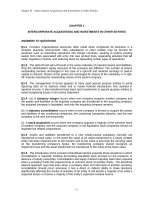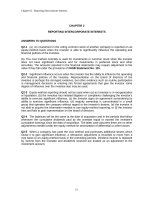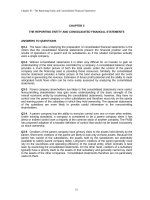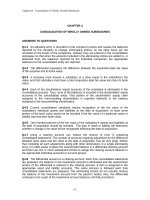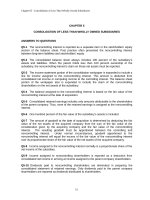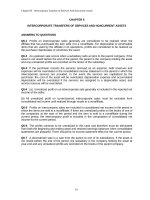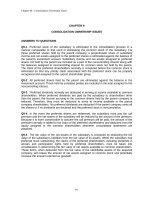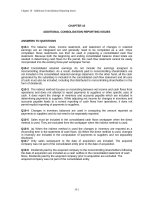Solution manual advanced financial accounting, 8th edition by baker chap007
Bạn đang xem bản rút gọn của tài liệu. Xem và tải ngay bản đầy đủ của tài liệu tại đây (278.83 KB, 89 trang )
Chapter 07 - Intercompany Inventory Transactions
CHAPTER 7
INTERCOMPANY INVENTORY TRANSACTIONS
ANSWERS TO QUESTIONS
Q7-1 All inventory transfers between related companies must be eliminated to avoid an
overstatement of revenue and cost of goods sold in the consolidated income statement. In
addition, when unrealized profits exist at the end of the period, the eliminations are needed to
avoid overstating inventory and consolidated net income.
Q7-2 An inventory transfer at cost results in an overstatement of sales and cost of goods
sold. While net income is not affected, gross profit ratios and other financial statement
analysis may be substantially in error if appropriate eliminations are not made.
Q7-3 An upstream sale occurs when the parent purchases items from one or more
subsidiaries. A downstream sale occurs when the sale is made by the parent to one or more
subsidiaries. Knowledge of the direction of sale is important when there are unrealized profits
so that the person preparing the consolidation workpaper will know whether to reduce
consolidated net income assigned to the controlling interest by the full amount of the
unrealized profit (downstream) or reduce consolidated income assigned to the controlling
and noncontrolling interests on a proportionate basis (upstream).
Q7-4 As in all cases, the total amount of the unrealized profit must be eliminated in
preparing the consolidated statements. When the profits are on the parent company's books,
consolidated net income and income assigned to the controlling interest are reduced by the
full amount of the unrealized profit.
Q7-5 Consolidated net income is reduced by the full amount of the unrealized profits. In the
upstream sale, the unrealized profits are apportioned between the parent company
shareholders and the noncontrolling shareholders. Thus, consolidated net income assigned
to the controlling and noncontrolling interests is reduced by a pro rata portion of the
unrealized profits.
Q7-6 Income assigned to the noncontrolling interest is affected when unrealized profits are
recorded on the subsidiary's books as a result of an upstream sale. A downstream sale
should have no effect on the income assigned to noncontrolling interest because the profits
are on the books of the parent.
Q7-7 The basic eliminating entry needed when the item is resold before the end of the
period is:
Sales
Cost of Goods Sold
XXXXXX
XXXXXX
The debit to sales is based on the intercorporate sale price. This means that only the
revenue recorded by the company ultimately selling to the nonaffiliate is to be included in the
consolidated income statement. Cost of goods sold is credited for the amount paid by the
purchaser on the intercorporate transfer, thereby permitting the cost of goods sold recorded
by the initial owner to be reported in the consolidated statement.
7-1
Chapter 07 - Intercompany Inventory Transactions
Q7-8 The basic eliminating entry needed when one or more of the items are not resold
before the end of the period is:
Sales
Cost of Goods Sold
Inventory
XXXXXX
XXXXXX
XXXXXX
The debit to sales is for the full amount of the transfer price. Inventory is credited for the
unrealized profit at the end of the period and cost of goods sold is credited for the amount
charged to cost of goods sold by the company making the intercompany sale.
Q7-9 Cost of goods sold is reported by the consolidated entity when inventory is sold to an
external party. The amount reported as cost of goods sold is based on the amount paid for
the inventory when it was produced or purchased from an external party. If inventory has
been purchased by one company and sold to a related company, the cost of goods sold
recorded on the intercorporate sale must be eliminated.
Q7-10 No adjustment to retained earnings is needed if the intercorporate sales have been
made at cost or if all intercorporate sales have been resold to an external party in the same
accounting period. If not all of the intercorporate sales have been resold by the end of the
period, consolidated retained earnings must be reduced by the parent's proportionate share
of any unrealized profits.
Q7-11 A proportionate share of the realized retained earnings of the subsidiary are assigned
to the noncontrolling interest. Any unrealized profits on upstream sales are deducted
proportionately from the amount assigned to the noncontrolling interest and consolidated
retained earnings. Unrealized profits on downstream sales are deducted entirely from the
retained earnings assigned to the consolidated entity.
Q7-12 When inventory profits from a prior period intercompany transfer are realized in the
current period, the profit is added to consolidated net income and to the income assigned to
the shareholders of the company that made the intercompany sale. If the unrealized profits
arise from a downstream sale, income assigned to the controlling interest will increase by the
full amount of profit realized. When the profits arise from an upstream sale, income assigned
to the controlling and noncontrolling interests will be increased proportionately in the period
the profit is realized. Thus, knowledge of whether the profits resulted from an upstream or a
downstream sale is imperative in assigning consolidated net income to the appropriate
shareholder group.
Q7-13 Consolidated retained earnings must be reduced by the full amount of any unrealized
profit on the parent company books.
Q7-14 Consolidated retained earnings must be reduced by the parent's proportionate share
of the unrealized profit on the subsidiary's books.
Q7-15* Sales between subsidiaries are treated in the same manner as upstream sales.
Whenever the profits are on the books of one of the subsidiaries, the unrealized profits at the
end of the period are eliminated and consolidated net income and income assigned to the
controlling and noncontrolling interests is reduced.
7-2
Chapter 07 - Intercompany Inventory Transactions
Q7-16* When a company is acquired in a business combination the transactions occurring
before the combination generally are regarded as transactions with unrelated parties and no
adjustments or eliminations are needed. All transactions between the companies following
the combination must be fully eliminated.
SOLUTIONS TO CASES
C7-1 Measuring Cost of Goods Sold
a. While the rule covers only a part of the elimination needed, Charlie is correct in that the
cost of goods sold recorded by the selling company must be eliminated to avoid overstating
that caption in the consolidated income statement.
b. The rules will result in the proper consolidated totals if rule #1 is expanded to include a
debit to sales and a credit to ending inventory for the amount of profit recorded by the
company that sold to its affiliate.
c. The way in which the rule is stated makes it appear to be incorrect, but it is correct. The
rule is appropriate in that the cost of goods sold recorded by the purchasing affiliate is equal
to the cost of goods sold to the first owner plus the profit the first owner recorded on the sale.
Eliminating these amounts therefore eliminates the appropriate amount of cost of goods sold.
If an equal amount of sales is eliminated, the rule should result in proper consolidated
financial statement totals.
d. The employee would be forced to look at the books of the selling affiliate and determine
the difference between the intercorporate sale price and the price it paid to acquire or
produce the items. If the items sold to affiliates are routinely produced and costs do not
fluctuate greatly, it may be possible to use some form of gross profit ratio to estimate the
amount of unrealized profit.
C7-2 Inventory Values and Intercompany Transfers
MEMO
To:
From:
Re:
President
Water Products Corporation
, CPA
Inventory Sale and Purchase of New Inventory
If Water Products holds only a small percent of the ownership of Plumbers Products and
Growinkle Manufacturing, it should have no difficulty in reporting the desired results. This
would not be the case if the two companies are subsidiaries of Water Products.
If both Plumbers Products and Growinkel are subsidiaries of Water Products, both the sale of
inventory to Plumbers Supply and the purchase of inventory from Growinkle Manufacturing
must be eliminated. In addition, the unrealized profit on any unsold inventory involved in
these transfers must be eliminated in preparing the financial statements for the current
period.
7-3
Chapter 07 - Intercompany Inventory Transactions
C7-2 (continued)
The consolidated income statement should include the same amount of income on the
inventory sold to Plumbers Supply and resold during the year as would have been recorded if
Water Products had sold the inventory directly to the purchaser. Any income recorded by
Water Products on inventory not resold by Plumbers Supply must be eliminated.
Similarly, the consolidated income statement should include the same amount of income on
the inventory purchased by Water Products and resold during the year as would have been
recorded if Growinkle Manufacturing had sold the inventory directly to the purchaser. Any
income recorded by Growinkle Manufacturing on inventory not resold by Water Products
must be eliminated.
Consolidated net income may increase if Plumbers Supply is able to sell the inventory it
purchased from Water Products at a higher price than would have been received by Water
Products or if it is able to sell a larger number of units. The same can be said for the
inventory purchased by Water Products from Growinkle Manufacturing. It is important to
recognize that the transfer of inventory between Water Products and its subsidiaries does not
in itself generate income for the consolidated entity.
An additional level of complexity may arise in this situation if Water Products uses the LIFO
inventory method. It might, for example, be forced to carry over its LIFO cost basis on the old
inventory sold to Plumbers Supply to the new inventory purchased from Growinkle
Manufacturing since it was replaced within the accounting period.
Primary citation:
ARB 51, Par. 6
7-4
Chapter 07 - Intercompany Inventory Transactions
C7-3 Intercorporate Inventory Transfers
MEMO
To:
Treasurer
Evert Corporation
From:
Re:
, CPA
Inventory Sale to Parent
This memo is prepared in response to your request for information on the appropriate
treatment of intercompany inventory transfers in consolidated financial statements. The
specific eliminating entries required in this case depend on the valuation assigned to the
inventory at December 31, 20X2.
Frankle Company sold inventory with a carrying value of $240,000 to Evert for $180,000 on
December 20, 20X2. Since the exchange price was well below Frankle’s cost, consideration
should be given to whether the inventory should be reported at $180,000 or $240,000 in the
consolidated statements at December 31, 20X2, under the lower-of-cost-or-market rule.
While the value of the inventory apparently had fallen below Frankle’s carrying value, the
accounting standards indicate no loss should be recognized when the evidence indicates
that cost will be recovered with an approximately normal profit margin upon sale in the
ordinary course of business. [ARB 43, Chapter 4, Par. 9]
We are told the management of Frankle considered the drop in prices to be temporary and
Evert was able to sell the inventory for $70,000 more than the original amount paid by
Frankle. It therefore seems appropriate for the consolidated entity to report the inventory at
Frankle’s cost of $240,000 at December 31, 20X2.
In preparing the consolidated statements at December 31, 20X2 and 20X3, the effects of the
intercompany transfer should be eliminated. [ARB 51, Par. 6]
The following eliminating entry is required at December 31, 20X2:
E(1) Sales
Inventory
Cost of Goods Sold
180,000
60,000
240,000
The above entry will increase the carrying value of the inventory to $240,000. Eliminating
sales of $180,000 and cost of goods sold of $240,000 will increase consolidated net income
by $60,000 and income assigned to the noncontrolling interest by $6,000 ($60,000 x .10).
These changes will result in an increase in consolidated retained earnings and the amount
assigned to the noncontrolling shareholders in the consolidated balance sheet by $54,000
and $6,000, respectively.
7-5
Chapter 07 - Intercompany Inventory Transactions
C7-3 (continued)
The following eliminating entry is required at December 31, 20X3:
E(2) Cost of Goods Sold
Retained Earnings
Noncontrolling interest
60,000
54,000
6,000
The above entry will reduce consolidated net income by $60,000 and income assigned to the
noncontrolling interest by $6,000 ($60,000 x .10). The credits to retained earnings and
noncontrolling interest are needed to bring the beginning balances into agreement with those
reported at December 31, 20X2.
No eliminations are required for balances reported at December 31, 20X3, because the
inventory has been sold to a nonaffiliate prior to year-end.
Primary citations:
ARB 43, CH 4, Par. 9
ARB 51, Par. 6
C7-4 Unrealized Inventory Profits
a. When the amount of unrealized inventory profits on the books of the subsidiary at the
beginning of the period is greater than the amount at the end of the period, the income
assigned to the noncontrolling interest for the period will exceed a pro rata portion of the
reported net income of the subsidiary.
b. The subsidiary apparently had less unrealized inventory profit at the end of the period
than it did at the start of the period. In addition, the parent must have had more unrealized
profit on its books at the end of the period than it did at the beginning. The negative effect of
the latter apparently offset the positive effect of the reduction in unrealized profits by the
subsidiary.
c. The most likely reason is that a substantial amount of the parent company sales was
made to its subsidiaries and the cost of goods sold on those items was eliminated in
preparing the consolidated statements.
d. A loss was recorded by the seller on an intercompany sale of inventory to an affiliate and
the purchaser continues to hold the inventory.
7-6
Chapter 07 - Intercompany Inventory Transactions
C7-5 Eliminating Inventory Transfers
a. If no intercompany sales are eliminated, the income statement may include overstated
sales revenue and cost of goods sold. The net impact on income will depend upon whether
there were more unrealized profits at the beginning or end of the year. If Ready Building does
not hold total ownership of the subsidiaries, the amount of income assigned to noncontrolling
shareholders is likely to be incorrect as well.
Inventory, current assets and total assets, retained earnings, and stockholders' equity are
likely to be overstated if inventories are sold to affiliates at a profit. If the companies pay
income taxes on their individual earnings, the amount of income tax expense also will be
overstated in the period in which unrealized profits are reported and understated in the
period in which the profits are realized.
b. Because profit margins vary considerably, the amount of unrealized profit may vary
considerably if uneven amounts of product are purchased by affiliates from period to period.
Ready Building needs to establish a formal system to monitor intercompany sales. Perhaps
the best alternative would be to establish a separate series of accounts to be used solely for
intercompany transfers. Alternatively, it may be possible to use unique shipping containers for
intercompany sales or to specifically mark the containers in some way to identify the
intercompany shipments at the time of receipt. The purchaser might then use a different type
of inventory tag or mark these units in some way when the product is received and placed in
inventory. Inventory count teams could then easily identify the product when inventories are
taken.
c. A number of factors might be considered. The most important inventory system is the one
used by the company making the intercompany purchase. When intercompany inventory
purchases are bunched at the end of the year, the amount of unrealized profit included in
ending inventory may be quite different under FIFO versus LIFO. If intercompany purchases
are placed in a LIFO inventory base, inventories may be misstated for a period of years
before the inventory is resold. Eliminating entries must be made each of the years until
resale to avoid a misstatement of assets and equities. In those cases where the
intercompany purchases are in high volume and the inventory turns over very quickly, a small
amount of inventory left at the end of the period may be immaterial and of little concern.
Typically, a parent will align inventory costing methods subsequent to a subsidiary acquisition
to avoid problems caused by differences in accounting for the same items or types of items.
7-7
Chapter 07 - Intercompany Inventory Transactions
C7-5 (continued)
d. It may be necessary to start by looking at intercorporate cash receipts and disbursements
to determine the extent of intercorporate sales. One or more months might be selected and
all vouchers examined to establish the level of intercorporate sales and the profit margins
recorded on the sales. For those products sold throughout the year, it may be possible to
estimate for the year as a whole based on an examination of several months. Once total
intercompany sales and profit margins have been estimated, the amount of unrealized profit
at year end should be estimated. One approach would be to take a physical inventory of the
specific product types which have been identified and attempt to trace back using the product
identification numbers or shipping numbers to determine what portion of the inventory on
hand was purchased from affiliates.
C7-6 Intercompany Profits and Transfers of Inventory
a. The intercompany transfers of Xerox (www.xerox.com) between segments are apparently
relatively insignificant because they are not reported in the notes to the consolidated financial
statements relating to segment reporting. For consolidation purposes, all significant
intercompany accounts and transactions are eliminated.
b. Exxon Mobil (www.exxonmobil.com) prices intercompany transfers at estimated market
prices. The amount of intercompany transfers is large. In the fiscal year ending December
31, 2006, Exxon Mobil reported eliminations of $368 billion of intersegment transfers, which
does not include intercompany transfers within segments. This amount represents nearly 50
percent of total reported segment sales. For consolidation purposes, Exxon Mobil eliminates
the effects of intercompany transactions.
c. Ford Motor Company (www.ford.com) intercompany transfers consist primarily of vehicles,
parts, and components manufactured by the company and its subsidiaries, with a smaller
amount of financial and other services included. The amount of intercompany transfers is
significant, totaling almost $4 billion, but is relatively small in relation to sales to unaffiliated
customers. The amount has been decreasing in recent years. The effects of intercompany
transfers are eliminated in consolidation.
7-8
Chapter 07 - Intercompany Inventory Transactions
SOLUTIONS TO EXERCISES
E7-1 Multiple-Choice Questions on Intercompany Inventory Transfers
[AICPA Adapted]
1.
a
2.
c
3.
a
4.
c
5.
c
6.
c
Net assets reported
Profit on intercompany sale
Proportion of inventory unsold at year end
($60,000 / $240,000)
Unrealized profit at year end
Amount reported in consolidated statements
Inventory reported by Banks ($175,000 + $60,000)
Inventory reported by Lamm
Total inventory reported
Unrealized profit at year end
[$50,000 x ($60,000 / $200,000)]
Amount reported in consolidated statements
7-9
$48,000
x
.25
$320,000
(12,000)
$308,000
$235,000
250,000
$485,000
(15,000)
$470,000
Chapter 07 - Intercompany Inventory Transactions
E7-2 Multiple-Choice Questions on the Effects of Inventory Transfers
[AICPA Adapted]
1.
b
Cost of goods sold reported by Park
Cost of goods sold reported by Small
Total cost of goods sold reported
Cost of goods sold reported by Park on
sale to Small ($500,000 x .40)
Reduction of cost of goods sold reported by
Small for profit on intercompany sale
[($500,000 x 4 / 5) x .60]
Cost of goods sold for consolidated entity
$ 800,000
700,000
$1,500,000
(200,000)
(240,000)
$1,060,000
Note:
Answer b in the actual CPA examination question was
$1,100,000, requiring candidates to select the closest
answer.
2.
d
$32,000
=
($200,000 + $140,000) –
$308,000
3.
b
$6,000
=
($26,000 + $19,000) – $39,000
4.
c
$9,000
=
Inventory held by Spin
($32,000 x .375)
Unrealized profit on sale
[($30,000 + $25,000) –
$52,000]
Carrying cost of inventory for
Power
5.
b
.20 = $14,000 / [(Stockholders’ Equity $50,000) +
(Patent $20,000)]
6.
b
14 years = ($28,000 / [(28,000 - $20,000) / 4
years]
$12,000
(3,000)
$ 9,000
E7-3 Multiple Choice – Consolidated Income Statement
c
1.
2.
b
3.
c
Total income ($86,000 - $47,000)
Income assigned to noncontrolling
interest [.40($86,000 - $60,000)]
Consolidated net income assigned
to controlling interest
7-10
$39,000
(10,400)
$28,600
Chapter 07 - Intercompany Inventory Transactions
7-11
Chapter 07 - Intercompany Inventory Transactions
E7-4 Multiple-Choice Questions — Consolidated Balances
1.
c
2.
a
Amount paid by Lorn Corporation
Unrealized profit
Actual cost
Portion sold
Cost of goods sold
$120,000
(45,000)
$ 75,000
x
.80
$ 60,000
3.
e
Consolidated sales
Cost of goods sold
Consolidated net income
Income to Dresser’s noncontrolling
interest:
Sales
Reported cost of sales
Report income
Portion realized
Realized net income
Portion to Noncontrolling
Interest
Income to noncontrolling
Interest
Income to controlling interest
$140,000
(60,000)
$ 80,000
4.
a
$120,000
(75,000)
$ 45,000
x
.80
$ 36,000
x
.30
(10,800)
$ 69,200
Inventory reported by Lorn
Unrealized profit ($45,000 x .20)
Ending inventory reported
$ 24,000
(9,000)
$ 15,000
E7-5 Multiple-Choice Questions — Consolidated Income Statement
1.
a
$20,000 = $30,000 x [($48,000 - $16,000) / $48,000]
2.
d
Sales reported by Movie Productions Inc.
Cost of goods sold ($30,000 x 2/3)
Consolidated net income
3.
a
$7,000 = [($67,000 - $32,000) x .20]
7-12
$67,000
(20,000)
$47,000
Chapter 07 - Intercompany Inventory Transactions
E7-6 Realized Profit on Intercompany Sale
a.
b.
c.
Journal entries recorded by Nordway Corporation:
(1)
Inventory
Cash (Accounts Payable)
960,000
(2)
Cash (Accounts Receivable)
Sales
750,000
(3)
Cost of Goods Sold
Inventory
600,000
960,000
750,000
600,000
Journal entries recorded by Olman Company:
(1)
Inventory
Cash (Accounts Payable)
750,000
(2)
Cash (Accounts Receivable)
Sales
1,125,000
(3)
Cost of Goods Sold
Inventory
750,000
750,000
1,125,000
750,000
Eliminating entry:
E(1)
Sales
Cost of Goods Sold
750,000
7-13
750,000
Chapter 07 - Intercompany Inventory Transactions
E7-7 Sale of Inventory to Subsidiary
a.
b.
c.
Journal entries recorded by Nordway Corporation:
(1)
Inventory
Cash (Accounts Payable)
960,000
(2)
Cash (Accounts Receivable)
Sales
750,000
(3)
Cost of Goods Sold
Inventory
600,000
960,000
750,000
600,000
Journal entries recorded by Olman Company:
(1)
Inventory
Cash (Accounts Payable)
750,000
(2)
Cash (Accounts Receivable)
Sales
810,000
(3)
Cost of Goods Sold
Inventory
540,000
750,000
810,000
540,000
Eliminating entry:
E(1)
Sales
Cost of Goods Sold
Inventory
750,000
7-14
708,000
42,000
Chapter 07 - Intercompany Inventory Transactions
E7-8 Inventory Transfer between Parent and Subsidiary
a.
Karlow Corporation reported cost of goods sold of $820,000 ($82 x 10,000 desks)
and Draw Company reported cost of goods sold of $658,000 ($94 x 7,000 desks).
b.
Cost of goods sold for the consolidated entity is $574,000 ($82 x 7,000 desks).
c.
Eliminating entry:
E(1)
d.
940,000
904,000
36,000
Eliminating entry:
E(1)
e.
Sales
Cost of Goods Sold
Inventory
Retained Earnings, January 1
Cost of Goods Sold
36,000
36,000
Eliminating entry:
E(1)
Retained Earnings, January 1
Noncontrolling Interest
Cost of Goods Sold
21,600
14,400
7-15
36,000
Chapter 07 - Intercompany Inventory Transactions
7-16
Chapter 07 - Intercompany Inventory Transactions
E7-9 Income Statement Effects of Unrealized Profit
a.
b.
Sale price to Holiday Bakery per bag ($900,000 / 100,000)
Profit per bag [$9.00 - ($9.00 / 1.5)]
Cost per bag
Bags sold by Holiday Bakery (100,000 - 20,000)
Consolidated cost of goods sold
E(1)
Sales
Inventory ($3.00 x 20,000 bags)
Cost of Goods Sold
$
9.00
(3.00)
$
6.00
x 80,000
$480,000
900,000
60,000
840,000
Required Adjustment to Cost of Goods Sold:
Cost of goods sold — Farmco ($900,000 / 1.5)
Cost of goods sold — Holiday ($9.00 x 80,000 units)
$ 600,000
720,000
$1,320,000
(480,000)
$ 840,000
Consolidated cost of goods sold ($6.00 x 80,000 units)
Required adjustment
c.
Operating income of Holiday Bakery
Net income of Farmco Products
$400,000
150,000
$550,000
(60,000)
$490,000
Less: Unrealized inventory profits
Consolidated net income
Less: Income assigned to noncontrolling interest
($150,000 - $60,000 unrealized profit) x .40
Income assigned to controlling interest
(36,000)
$454,000
Alternate computation:
Operating income of Holiday Bakery
Net income of Farmco Products
Unrealized profits ($3.00 x 20,000 units)
Realized net income
Ownership held by Holiday Bakery
Income assigned to controlling interest
7-17
$150,000
(60,000)
$ 90,000
x
.60
$400,000
54,000
$454,000
Chapter 07 - Intercompany Inventory Transactions
E7-10 Prior-Period Unrealized Inventory Profit
a.
Cost per bag of flour ($9.00 / 1.5)
Bags sold
Cost of goods sold from inventory held, January 1, 20X9
b.
Assuming the basic equity method is used by Holiday Bakery in
accounting for its investment in Farmco Products, the following
eliminating entry is needed:
E(1)
c.
Retained Earnings, January 1
Noncontrolling Interest
Cost of Goods Sold
$60,000 = 20,000 bags x $3.00
$
6.00
x 20,000
$120,000
36,000
24,000
Operating income of Holiday Bakery
Net income of Farmco Products
60,000
$300,000
250,000
$550,000
60,000
$610,000
Add: Inventory profits realized in 20X9
Consolidated net income
Less: Income assigned to noncontrolling shareholders
($250,000 + $60,000) x .40
Income assigned to controlling interest
(124,000)
$486,000
Alternate computation:
Operating income of Holiday Bakery
Net income of Farmco Products
Inventory profits realized in 20X9
Realized net income
Ownership held by Holiday Bakery
$250,000
60,000
$310,000
x
.60
Income assigned to controlling interest
7-18
$300,000
186,000
$486,000
Chapter 07 - Intercompany Inventory Transactions
E7-11 Computation of Consolidated Income Statement Data
a.
Reported sales of Prem Company
Reported sales of Cooper Company
Intercompany sales by Prem Company in 20X5
Intercompany sales by Cooper Company in 20X5
Sales reported on consolidated income statement
b.
$ 30,000
80,000
Cost of goods sold reported by Prem Company
Cost of goods sold reported by Cooper Company
$400,000
200,000
$600,000
(110,000)
$490,000
$250,000
120,000
$370,000
(100,500)
$269,500
Adjustment due to intercompany sales
Consolidated cost of goods sold
Adjustment to cost of goods sold:
c.
d.
CGS charged by Prem on sale to Cooper
CGS charged by Cooper ($30,000 - $6,000)
Total charged to CGS
CGS for consolidated entity
$20,000 x ($24,000 / $30,000)
Required adjustment to CGS
$ 20,000
24,000
$ 44,000
CGS charged by Cooper on sale to Prem
CGS charged by Prem ($80,000 - $20,000)
Total charged to CGS
CGS for consolidated entity
$50,000 x ($60,000 / $80,000)
Required adjustment to CGS
Total adjustment required
$ 50,000
60,000
$110,000
(16,000)
(37,500)
Reported net income of Cooper Company
Unrealized profit on sale to Prem Company
$30,000 x ($20,000 / $80,000)
Realized net income
Noncontrolling interest's share
Income assigned to noncontrolling interest
Reported net income of Pem Company
Less: Income from subsidiary
Net income of Cooper Company
Operating income
Less: Unrealized inventory profits of Prem
Company [$10,000 x ($6,000 / $30,000)]
Unrealized inventory profits of Copper
Company [$30,000 x ($20,000 / $80,000)]
Income assigned to noncontrolling
interest
Income assigned to controlling interest
7-19
$ 28,000
72,500
$100,500
$ 45,000
(7,500)
$ 37,500
x
.40
$ 15,000
$107,000
(27,000)
$ 80,000
45,000
$125,000
$ 2,000
7,500
15,000
(24,500)
$ 98,500
Chapter 07 - Intercompany Inventory Transactions
7-20
Chapter 07 - Intercompany Inventory Transactions
E7-12 Sale of Inventory at a Loss
a.
Entries recorded by Trent Company
Inventory
Cash
Purchase inventory.
400,000
Cash
Sales
Sale of inventory to Gord Corporation.
300,000
Cost of Goods Sold
Inventory
Record cost of goods sold.
400,000
400,000
300,000
400,000
Entries recorded by Gord Corporation
Inventory
Cash
Purchase of inventory from Trent.
300,000
Cash
Sales
Sale of inventory to nonaffiliates.
360,000
Cost of Goods Sold
Inventory
Record cost of goods sold:
$180,000 = $300,000 x .60
180,000
b.
Consolidated cost of goods sold for 20X8 should be reported
as $240,000 ($400,000 x .60).
c.
Operating income reported by Gord
Net income reported by Trent
Unrealized loss on intercorporate sale
($400,000 - $300,000) x .40
Consolidated net income
Income to assigned to noncontrolling interest
($120,000 x .25)
Income assigned to controlling interest
7-21
$ 80,000
40,000
300,000
360,000
180,000
$230,000
120,000
$350,000
(30,000)
$320,000
Chapter 07 - Intercompany Inventory Transactions
E7-12 (continued)
d.
Eliminating entry, December 31, 20X8:
E(1)
Sales
Inventory
Cost of Goods Sold
300,000
40,000
340,000
Computation of cost of goods sold to be eliminated
Cost of goods sold recorded by Trent
Cost of goods sold recorded by Gord
Total recorded
Consolidated cost of goods sold
Required elimination
7-22
$400,000
180,000
$580,000
(240,000)
$340,000
Chapter 07 - Intercompany Inventory Transactions
E7-13 Intercompany Sales
a.
Consolidated net income for 20X4:
Operating income of Hollow Corporation
Net income of Surg Corporation
$160,000
90,000
$250,000
(15,000)
$235,000
Less: Unrealized profit — Surg Corporation
Consolidated net income
b.
c.
Inventory balance, December 31, 20X5:
Inventory reported by Hollow Corporation
Unrealized profit on books of Surg
Corporation
($135,000 - $90,000) x ($30,000/$135,000)
$ 30,000
Inventory reported by Surg Corporation
Unrealized profit on books of Hollow
Corporation
($280,000 - $140,000) x ($110,000/$280,000)
Inventory, December 31, 20X5
$110,000
(10,000)
55,000
$75,000
Consolidated cost of goods sold for 20X5:
CGS on sale of inventory on hand January 1, 20X5
$45,000 x ($120,000 / $180,000)
CGS on items purchased from Surg in 20X5
($135,000 - $30,000) x ($90,000 / $135,000)
CGS on items purchased from Hollow in 20X5
($280,000 - $110,000) x ($140,000 / $280,000)
Total cost of goods sold
d.
(55,000)
$20,000
$ 30,000
70,000
85,000
$185,000
Income assigned to controlling interest:
Operating income of Hollow Corporation
Net income of Surg Corporation
Add: Inventory profit of prior year realized in 20X5
Less: Unrealized inventory profit — Surg Corporation
Unrealized inventory profit — Hollow Corporation
Income to noncontrolling interest
($85,000 + $15,000 - $10,000) x .30
Income assigned to controlling interest
7-23
$220,000
85,000
$305,000
15,000
(10,000)
(55,000)
(27,000)
$228,000
Chapter 07 - Intercompany Inventory Transactions
E7-14 Consolidated Balance Sheet Workpaper
a.
Eliminating entries:
E(1)
E(2)
E(3)
Common Stock — Hingle Company
Retained Earnings
Investment in Hingle Company Stock
Noncontrolling Interest
Eliminate investment balance.
150,000
250,000
Retained Earnings
Noncontrolling Interest
Inventory
Eliminate unrealized inventory profit
of Hingle Company.
28,000
12,000
Retained Earnings
Inventory
Eliminate unrealized inventory profit
of Doorst Corporation.
10,000
b.
280,000
120,000
40,000
10,000
Doorst Corporation and Hingle Company
Consolidated Balance Sheet Workpaper
December 31, 20X8
Item
Cash and Receivables
Inventory
Buildings and Equipment
(net)
Investment in Hingle
Company Stock
Debits
Accounts Payable
Common Stock
Retained Earnings
Noncontrolling Interest
Credits
Doorst
Corp.
Hingle
Co.
98,000
150,000
40,000
100,000
310,000
280,000
280,000
838,000
420,000
70,000
200,000
568,000
20,000
150,000
250,000
838,000
7-24
420,000
Eliminations
Debit
Credit
(2) 40,000
(3) 10,000
Consolidated
138,000
200,000
590,000
(1)280,000
(1)150,000
(1)250,000
(2) 28,000
(3) 10,000
(2) 12,000
450,000
928,000
90,000
200,000
(1)120,000
450,000
530,000
108,000
928,000
Chapter 07 - Intercompany Inventory Transactions
E7-15* Multiple Transfers between Affiliates
a.
Entries recorded by Klon Corporation
Cash
Sales
Sale of inventory to Brant Company.
150,000
Cost of Goods Sold
Inventory
Record cost of goods sold.
100,000
150,000
100,000
Entries recorded by Brant Company
Inventory
Cash
Purchase of inventory from Klon.
150,000
Cash
Sales
Sale of inventory to Torkel Company.
150,000
Cost of Goods Sold
Inventory
Record cost of goods sold.
150,000
150,000
150,000
150,000
Entries recorded by Torkel Company
Inventory
Cash
Purchase of inventory from Brant.
150,000
Cash
Sales
Sale of inventory to nonaffiliates.
120,000
Cost of Goods Sold
Inventory
Record cost of goods sold.
90,000
b.
Cost of goods sold for 20X8 should be reported as $60,000
[$90,000 x ($100,000 / $150,000)].
c.
Inventory at December 31, 20X8, should be reported at $40,000
[$60,000 x ($100,000 / $150,000)].
7-25
150,000
120,000
90,000
